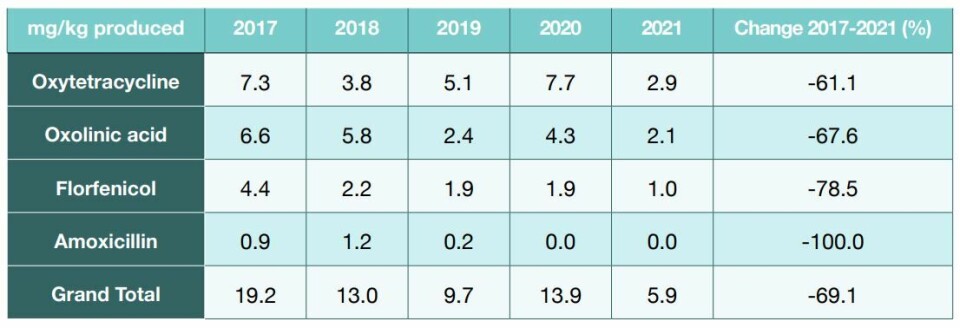
Only 4.9% of Scottish salmon farms used antibiotics last year
But volume of drugs given was higher than 2020 due to treatment of bigger fish
The use of antibiotics in the Scottish salmon farming sector increased last year compared to 2020 but was restricted to a relatively small number of farms, the Responsible Use of Medicines in Agriculture Alliance (RUMA) has revealed.
Antibiotics were used in 8.5% of freshwater farms and 4.9% of marine farms. Usage increased from 29.3 mg/kg in 2020 to 43.1 mg/kg.
“Overall use is skewed by a relatively small number of treatments during the marine phase, where larger fish require proportionately higher volumes of antibiotic to ensure safe and effective treatment,” the RUMA report stated.
“When comparing use between years, it is evident that overall increases in antibiotic use over time can be the result of only small increases in the actual number of farms treated.”
Climate change
The report pointed out that farmed salmon were sensitive to climate change and that changes in the seasonal temperature profile impacted the development and physiology of the fish as well as many of the pathogens and organisms that can affect them, including jellyfish and other plankton.
“In 2021, salmon farmers were rearing higher than usual biomasses of fish on farms across the sector, as a lasting impact of the Covid pandemic – a situation that was reported in 2020. The challenges surrounding farming in the wild, combined with globally relevant challenges, have placed pressure on fish health management and the control of sometimes complex fish health issues,” wrote RUMA.

More fish in the water
Dr Iain Berrill, head of technical at trade body Salmon Scotland, and a member of RUMA’s Targets Task Force, said: “Like any medicine antibiotics are used responsibly, sparingly and only when required in the health and welfare interests of our fish, and only under prescription from licensed veterinarians.
“2021 was a record year for salmon production, with more fish in the water for longer due to the loss of markets as a result of Covid. The requirement to protect our fish from environmental challenges meant antibiotics were used on a small number of farms. We are committed to reducing use as low as possible.”
All farmed salmon were vaccinated, and no HP-CIAs (Highest Priority Critically Important Antibiotics for human medical purposes) were used.
The trout sector, which has a target of maintain usage below 20 mg/kg, reduced its antibiotic usage from 13.9 mg/kg in 2020 to 5.9 mg/kg last year.
This is regarded as probably the lowest usage that is practically possible, as treatment cannot be withheld on welfare grounds.

Cat McLaughlin, chair of RUMA and the RUMA Targets Task Force 2 said she continued to be impressed and was full of praise for the work of UK agriculture and aquaculture in its efforts to tackle antimicrobial resistance (AMR) by reducing antibiotic use.
“Some sectors, in response to specific disease outbreaks or other factors, have seen some increases in usage in order to effectively address these challenges and protect animal welfare, McLaughlin said in the introduction to the RUMA report.
“This reinforces the point that antibiotics are a vital tool to ensure healthy animals and high welfare standards and the focus is not on zero use, but responsible use. All sectors continue to strive to keep antibiotics effective and fit for purpose and only use when necessary.”






















































